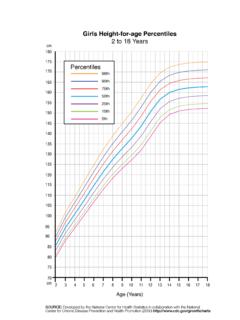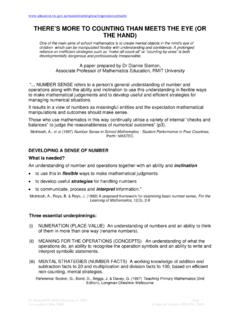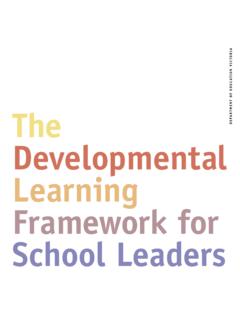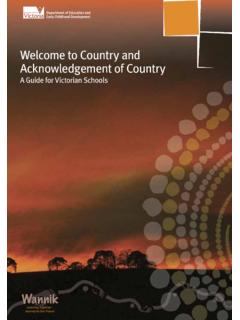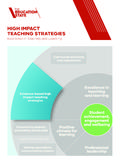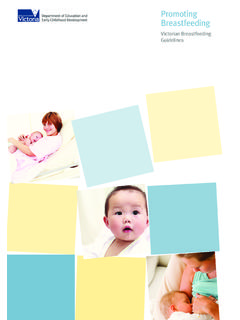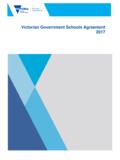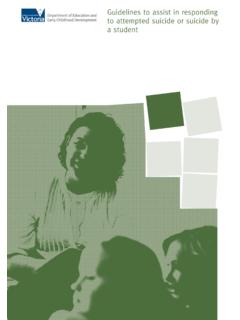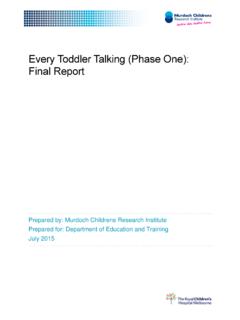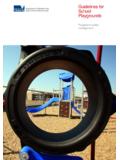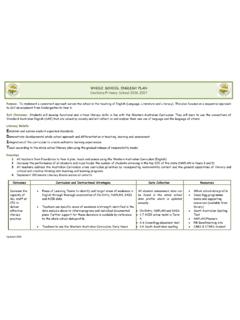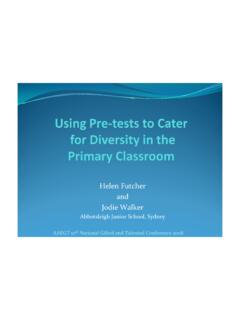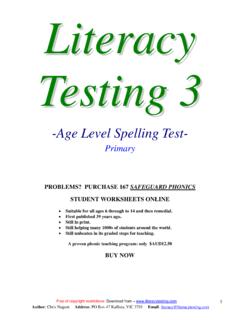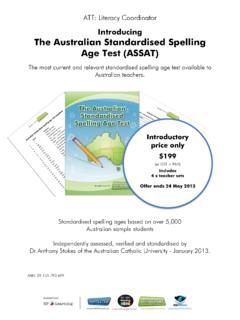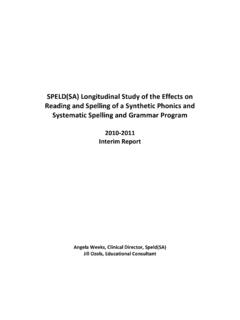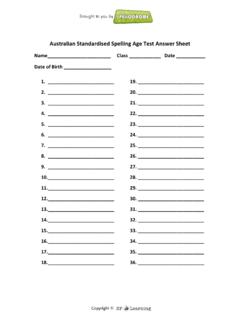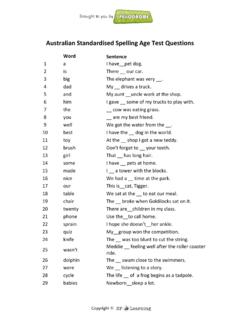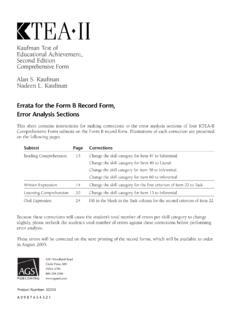Transcription of The Words Children Write 2008 - Department of Education ...
1 Oxford Wordlist Research StudyAn investigation of high frequency Words in young Children s writing and reading developmentProfessor Joseph Lo Bianco Janet ScullDebra IvesThe Words Children Write2008 Research Summary of the2 PrefaceThe Oxford Wordlist research study, An investigation of high frequency Words in young Children s writing and reading development, was conducted in australian schools in 2007. This study is the first of its type in over 30 that consider and connect the Words used by our broad student community to the classroom increase their relevancy as they are included and referred to in reading, writing and spelling lists. Following repeated requests from educators to be provided with an up-to-date list that reflects australian students of today, Oxford University Press Australia conducted an extensive and rigorous study to find those Words most frequently used by students in their first three years of school in their own writing.
2 The research was designed by Professor Joseph Lo Bianco and Janet Scull from the University of Melbourne, and they have continued their involvement by analyzing the final Oxford University Press research team was led by Julie Baillie. Julie s work in early years classrooms for over 20 years, and in her role at the school, district and state level working with educators, schools and Education systems to drive literacy improvement, was instrumental in the formation of this study. The Oxford Wordlist, the 307 most frequently used Words , has been presented as a resource freely available to all australian educators and this publication, The Words Students Write : Research Summary of the Oxford Wordlist, An investigation of high frequency Words in young Children s writing and reading development, is the analysis of this Oxford Wordlist research teamJulie BaillieResearch Manager: Primary Division Oxford University Press AustraliaJulie supported schools, school leaders and educators in all aspects of the process of this study.
3 She collated the data that led to the Oxford Wordlist, and the analysis of this data presented in this research MoralesSenior Publishing Editor: Primary Division Oxford University Press AustraliaWith a 15 years experience in multimedia design, Rosanna was instrumental in designing the Oxford Wordlist interactive data collection tool developed to facilitate the collection of research data and its there is extensive research into Children s spoken language development, and of their early reading, Children s writing appears to be less well documented. Building from this premise Oxford University Press conducted the research reported below, An investigation of high frequency Words in young Children s writing and reading development, and from this produced the Oxford general aim of the research was to document the Words Children first Write , to examine these choices according to a range of Children s demographic characteristics, and to explore what these word choices indicate about Children s personal identities and social research on the Words Children Write should therefore be understood in the context of the complex and mutually reinforcing growth of Children s language: speaking, listening, reading and writing and their educational, social and personal can we learn from the Words Children use in their earliest samples of writing?
4 What do the Words young writers use reveal about Children as writers and also about the individual person, his or her subjectivity and interests? What can we infer from the word selections that Children make about the influences on them; influences such as gender, social or familial opportunity, ethnic and linguistic background and place of residence? What do Children s word choices tell teachers about the teaching of reading and writing? These are some of the many questions raised when conducting and interpreting the Oxford Wordlist the most general, and ideal, terms infants learn language first by learning nouns. This is a process of nominalizing, naming the world that surrounds them. These nouns that name the world are then qualified, described, given agency, organized and arranged, in other Words they are put to work, meeting the child s growing needs for communication. In this way Children convert a naming tool into an instrument for social interaction, in turn confirming language as the deepest and most reliable tool a child has available for controlling his or her world.
5 Infants are supported in their early language growth by a veritable cottage industry of targeted communication. Practically every adult engages verbally with infants, tutoring them in their growing language competence, indulging or correcting errors, providing continuous communication. This is a many-to-one profile of communication between intimates and a dependent child. In this scaffolded and attentive environment Children develop grammatical accuracy, lexical range and socio-cultural appropriateness. School involves a radically different communication profile. Here the supportive environment directed at a single child is reversed into a one-to-many communication profile. In classrooms Children become multiples, rather than single targets of directed communication, they become students and enter formal relationships with adults who are no longer intimates but professionals in loco parentis. The single source of communicative input, the teacher, must divide his or her time among many schooling the astonishingly complex process of language acquisition is further extended into literacy.
6 Speaking and listening are connected through meaningful interaction and reading and writing elaborate these primary language processes into formal routines of knowledge acquisition. The speaking/listening pair is complemented by the reading/writing pair with one being mostly productive and the other mostly receptive. Schools therefore extend the primary 4language socialisation of the home and induct Children into the two literate equivalents of home communication: reading and writing. Reading, like listening, involves absorbing the messages of others; writing, like speaking, involves using the most elaborate manifestation of language to communicate messages to others. As young Children learn to read they draw heavily on their spoken language repertoire, as they learn to Write they draw heavily on their reading skills. There is a close relation between the particular language skill being acquired and the one already mastered, the range and nature of each skill that Children have under control informs and stimulates subsequent skill development, in an organic, cumulative and mutually reinforcing way.
7 Both of the receptive skills (what they understand of the language of others, especially teachers, parents and peers) are analogues of their productive skills (what they produce, in speech, proto-writing and early writing). Reading is a source of language input and writing is a form of language output; each skill grows in mutual relation to the other. In the beginning stages Children read Words that most easily fall within their spoken language experiences and this holds true of what they Write . Over time the strict interdependency between speech and writing, along with the relation between concrete and abstract ideas, diverges, and so too does the curriculum of schools. Each involves tools that serve to mediate the experience: pens, paper, keyboards and ever more integrated digital tools. All encapsulate the expanding codes that store symbolic information and are delivered through diverse modes of communication and come to represent ever more sophisticated meanings (Lo Bianco and Freebody, 2001).
8 Research methodology and designThe principal aim of the Oxford Wordlist research was to gather a sufficiently large and representative sample of Children s free writing to facilitate differentiated analysis of some key characteristics. As a result, the methodological challenge was to generate a sample sufficiently large to permit reliable analysis of both overall and sub-group characteristics, and to elicit the sample texts in asnaturalistic a way as possible. Moreover, it was essential to tap into Children s authentic writing in such a way as to uncover both what is common to all young writers and what differentiations exist. The research was intended to be cross-sectional, rather than longitudinal, and so few comments are made about dynamic aspects of Children s word usage, other than references to what can be gleaned from comparison with previous research on Children s early written Words . The cross-sectional, point-in-time sampling permits the researchers to observe contemporary australian English in use in the most de-contextualized and elaborate of the four main language was decided to restrict the sample to the writing practices of Children in the first three years of school.
9 The main demographic differentiations investigated were gender, socio-economic status, language background and location. Feasibility constraints determined population size and spread, so that it was decided to gather writing samples from 1000 Children in two states, Victoria and South Australia. Relevant processes were followed to gain permission from the governing educational authorities allowing researchers access to schools. Proportions for each of the selected demographic factors were calculated using the australian Census figures (ABS, 2007), enabling participant numbers in each of these cohorts to be broadly reflective of its representation in the whole australian writing samples were collected from participating Children in the first year of school and three samples from Children in the second and third years of school. The reason for collecting five writing samples from first year students was to provide a similar overall total word count to that which would be yielded from the samples collected from samples in years 2 and 3.
10 To preserve as naturalistic a process as possible, sample collection was allocated to classroom teachers who were requested to conserve texts produced by their students during regular writing sessions. In this way, the Children were also free to use the writing tools and aids regularly available in their classrooms and this facilitated their use of the Words they wanted to Write rather than being limited to those Words they could or were asked to Write . While acknowledging that the classroom focus on specific topics might influence the content or choice of text type and hence the grammatical structure of the collected texts, the condition of instruction to teachers was that they should collect samples of undirected or free writing. The aim was to ensure that the sample would tap into Children s relatively unconstrained expression and provide evidence of personally preferred word choices, hypothesizing that this would throw light on the personal lives, skills and interests of the Children following demographic data is from the 3776 samples included in the analysis.
